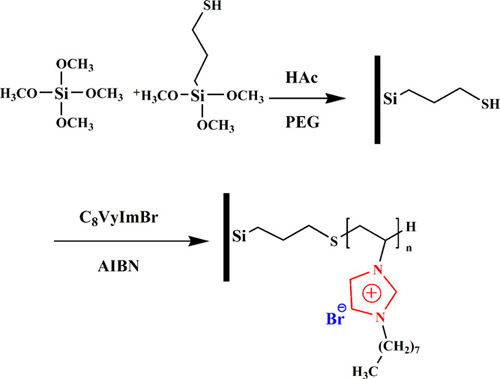Abstract:
A polymeric ionic liquid (PIL) modified hybrid monolithic column for CEC was synthesized on the basis of mercaptopropy-functionalized (MP-silica) hybrid monolithic column which was prepared by the in situ co-condensation of tetramethoxysilane and 3-mercaptopropyltrimethoxysilane via a sol–gel process. The PIL modified (PImC8-silica) hybrid monolithic column, which was characterized by FT-IR and Xray Photoelectron spectroscopy (XPS), generated a strong reversed and relatively stable EOF in a wide range of pH (3.0–8.0). The PImC8-silica hybrid monolithic column was evaluated by the separation of three aromatic hydrocarbons (AHs), four alkylbenzenes and five phenols, respectively, with phosphate buffers containing different ratios of acetonitrile as mobile phase. Reproducibilities of the column were also investigated by measuring RSDs of the migration time for AHs. RSDs of run-to-run (n = 5), dayto-day (n = 3) and column-to-column (n = 3) were in the range of 0.26–0.87%, 0.90–3.2% and 1.5–5.7%, respectively.
 |
| Scheme of PImC8-silica hybrid monolithic column preparation. |
A mercaptopropy-functionalized silica hybrid monolithic column was prepared by the in situ co-condensation of TMOS and MPTS. The obtained MP-silica hybrid monolith was a homogenous monolithic matrix characterized by SEM. The monomer [C8VyIm]Br was then polymerized on MP-silica hybrid monolith through surface radical chain-transfer polymerization and the successful incorporation of PIL to the MP-silica hybrid monolith was characterized by FT-IR and XPS. The obtained PImC8-silica hybrid monolithic column provided a reversed EOF in a wide pH range (3.0–8.0). Aromatic hydrocarbons, lkylbenzenes and phenols were well separated on the PImC8-silica hybrid monolithic column within a short time by using a mobile phase containing 40–45% ACN in CEC. Multiple interactions including hydrophobic effect and π- π interactions between analytes and functionalized groups (the ring of benzene and imidazole) existed in the CEC separation.


